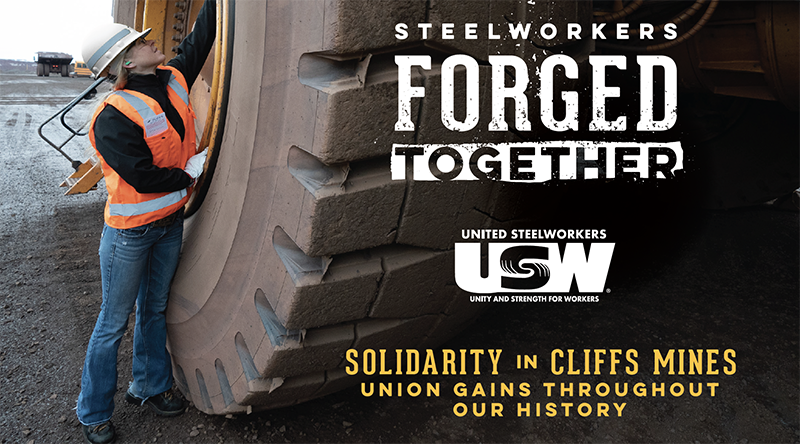
Click here to download this as a PDF.
Stronger Together
Since the opening of the iron ore mines in Minnesota and Michigan, workers have bravely fought for basic rights, protections and fairness on the job. We sacrificed when times were tough, and stood up for what we deserved when the industry rallied.
Our success over the years is a result of the solidarity of workers - and the unyielding support of our communities. When the bosses threatened our jobs, took out ads in the papers and sent letters home, our families stood with us. When employers tried to divide us, we organized and stuck together for safe, secure jobs and fair wages and benefits.
Today, we continue this tradition by bargaining together for our contracts at Utac, Hibtac and Tilden.
History Highlights
1800s: Large numbers of immigrants came to Minnesota and Michigan to work in the mines. The multi-racial workforce organized in different languages to fight for basic rights and better lives.
1907: Immigrant miners organized a first large-scale strike on the Mesabi Range with support from the Western Federation of Miners, calling for safer working conditions, a minimum wage, and an eight-hour workday.
1916: Another strike broke out on the Mesabi Range with support from the Industrial Workers of the World (IWW) for better wages and safer working conditions.
1936: The Steel Workers Organizing Committee (SWOC) formed with help from the United Mine Workers.
1942: Local Unions from Chisholm, Hibbing and other areas in the Iron Range participated in the United Steelworkers of America’s founding convention in Cleveland.
1946: Miners joined the post-war strike wave of 1945–1946 to win union recognition. The 104- day strike also led to significant wage increases.
1968: USWA established its $25 million Strike and Defense Fund.
1974: Approximately 10,300 miners struck against five employers at sites including the Empire Mine, Tilden Mine, and Eveleth Taconite and won a dental plan, time and a half holiday pay, and significant wage and benefit increases.
1977: 17,000 miners in Michigan and Minnesota went on a 113- day strike to close the wage gap in the industry, won pay improvements as well as vision care, air-conditioned lunchrooms and company-provided work gloves.
1980: The USW resorted to trade complaints and swift contract settlement in response to steel product dumping from overseas and the economic recession.
1983: Facing massive layoffs and widespread plant closure, due to a recession and unfair trade, locals approved a concessionary contract as taconite production plummeted.
1987: Tilden miners fought for what they deserved despite the employer’s attempt to convince the community that concessions would save the Tilden Mine.
1990: Union miners mobilized and rallied from the Iron Range to Cleveland to put pressure on the employer and ended a 123- day strike, winning significant pay and benefits.
1993: Members engaged in a 38-day strike to beat back the employer’s concessionary proposals that would create a two-tier system, attack retirement security and gain more control over our work life. As part of the new six-year agreement, Voluntary Employee Benefit Associations (VEBAs) are created to begin pre-funding retiree healthcare costs.
1997-2002: The union led a successful fight for steel tariffs to stop import dumping and save the industry. The Stand Up for Iron Ore and Stand Up for Steel campaigns were funded as part of the 1999 contract.
1998: Lois Jensen and her colleagues mobilized to address the brutal harassment faced by women working in the Eveleth iron mines and won the first class-action sexual harassment lawsuit in the United States. Jensen’s story became the basis for the movie “North Country.”
1999: Despite reduced iron ore demand, a flood of steel imports into the United States and the bankruptcy of five steel companies, members won pattern improvements in wages, pension, health care benefits, supplemental unemployment benefits, and contracting out language.
2003: EvTac (Thunderbird), originally owned by Ford, declared bankruptcy in May 2003 after 37 years in operation. Cliffs and Laiwu Steel acquired it out of bankruptcy court in December 2003.
2004: After several years of bankruptcies in the steel industry, the union negotiations included a landmark $220 million investment in retirement security, including nearly $100 million in VEBA retiree healthcare pre-funding and more than $120 million in pension funding. A new VEBA was created to help EvTac retirees, who lost their retiree insurance in bankruptcy.
2008: Workers won a new profit-sharing calculation based on Cliffs’ Iron Ore segment Earnings Before Interest and Taxes (EBIT), with a maximum payout up to $10 per hour, replacing the former mine-level Performance Bonus program. They also won wage increases of at least 4 percent each year and significant increases in the pension multiplier, including a $100 multiplier for future service. This also removed a cap on retiree benefits that was to go into effect in 2009.
2012: A new contract increased the profit sharing max to $11 per hour, provided wage increases and bonuses, preserved the current health care for active members, and continued to provide uncapped retiree health care benefits for our pre-Jan. 1, 2015 retirees and surviving spouses.
2015: As the employer faced bankruptcy, union members stood strong to refuse concessions, maintain benefits and keep provisions the company sought to reduce or eliminate. A new VEBA was created and funded with $2 million each year to subsidize health care premiums for post- Jan. 1, 2015 retirees.
2018: Union workers stood strong to win wage increases totaling $4.25 per hour, a $5,000 bonus and increases in pension benefits and relief for post- Jan. 1, 2015 retirees on retiree health insurance premiums. We were also able to ensure there were no changes in active or retiree health insurance (except for some modest improvements), no active insurance premiums and none of the unnecessary concessions the other steel companies had sought.
